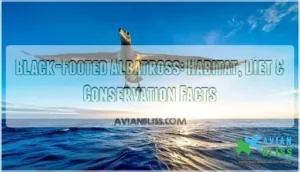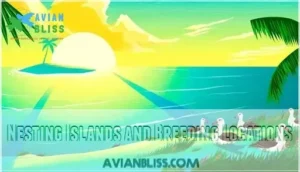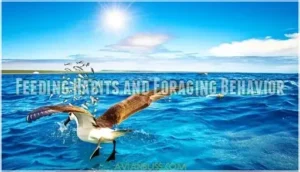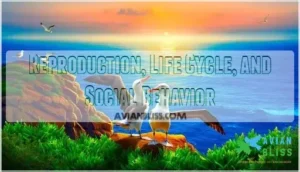This site is supported by our readers. We may earn a commission, at no cost to you, if you purchase through links.

These dark-plumaged wanderers represent one of nature’s most impressive feats of endurance—some individuals live over four decades while covering millions of miles during their lifetime. Yet despite their astonishing abilities, fewer than 130,000 of these splendid seabirds remain in the wild, making every encounter with them a privilege worth understanding.
Table Of Contents
- Key Takeaways
- Black-Footed Albatross: Species Overview
- Natural Habitat and Geographic Range
- Feeding Habits and Foraging Behavior
- Reproduction, Life Cycle, and Social Behavior
- Conservation Status and Threats
- Frequently Asked Questions (FAQs)
- What is a black-footed albatross called?
- What is the Hawaiian name for the black-footed albatross?
- What is another name for the albatross?
- What is the rarest albatross?
- What is the population of the black-footed albatross?
- Why is the black-footed albatross endangered?
- How do black-footed albatrosses navigate vast oceans?
- What social behaviors do black-footed albatrosses exhibit?
- How do black-footed albatross populations differ globally?
- What is the impact of climate change on black-footed albatrosses?
- Conclusion
Key Takeaways
- Black-footed albatrosses demonstrate extraordinary endurance with wingspans up to seven feet and lifespans exceeding 40 years, yet only 130,000 individuals remain due to threats from longline fishing bycatch killing 4,000-8,000 birds annually, plastic pollution, and climate-driven habitat loss on low-lying Hawaiian nesting islands.
- These seabirds form lifelong monogamous bonds and breed almost exclusively (97%) in the Northwestern Hawaiian Islands, with Midway Atoll and Laysan Island supporting 70% of all breeding pairs, making habitat protection in this concentrated region critical for species survival.
- Their foraging strategy spans thousands of miles across the North Pacific, tracking seasonal prey concentrations from Alaska to California through surface feeding on squid, flying fish eggs, and mesopelagic fish while serving as ecological indicators of overall ocean health.
- Conservation efforts show modest success with population growth at 0.3% annually after rebounding from historical crashes, but each major colony still faces a 23-35% probability of significant decline over 60 years without continued intervention targeting fishery reforms and marine protected areas.
Black-Footed Albatross: Species Overview
If you’re going to understand the Black-footed Albatross, you need to start with the basics—what it’s, what it looks like, and how you can tell it apart from its oceanic cousins.
This section breaks down the bird’s scientific identity, its physical traits, and the key features that set it apart. Let’s walk through what makes this seabird unique.
Scientific Classification and Naming
The Black-footed Albatross belongs to the genus Phoebastria and carries the species name nigripes—a Latin nod to its defining black feet, where "niger" means black and "pes" means foot.
This albatross species sits within the family Diomedeidae and the order Procellariiformes, grouping it with petrels and shearwaters.
Taxonomy systems and phylogenetic analysis place it among North Pacific albatross species, making classification methods straightforward for field ornithologists tracking Black-footed Albatross populations.
Physical Characteristics and Identification
You’ll recognize this seabird by its striking size—a wingspan stretching six to seven feet across open water, with a heavy build and long, narrow wings built for smooth gliding.
These black-footed albatross description details make albatross identification straightforward when you’re scanning the horizon.
- Body Size: 25–29 inches long, weighing 5–9.5 pounds
- Plumage Color: Mostly dusky brown with a milky wash over the face
- Beak Structure: Long, sharp-edged, hooked bill in dark tones
- Feather Patterns: Uniform brown across the body, white markings around bill base
Distinguishing Features From Similar Species
When scanning flocks at sea, plumage comparison becomes your sharpest tool—Black-footed Albatrosses stay uniformly dark brown, while Laysan Albatrosses flash white heads and bellies. Bill coloration matters too: short-tailed species show bubble-gum pink versus the dark tones here. Relative size and measurements help with species differentiation—Black-footed albatrosses appear stockier with a forward-leaning flight posture.
Hybridization patterns occasionally blur the lines, producing smoky-gray offspring, but underwing analysis seals albatross identification every time. Understanding the species’ marine environment habits is essential for effective conservation efforts.
Natural Habitat and Geographic Range
The Black-footed Albatross roams a vast stretch of the North Pacific, from the waters off Alaska down to California’s coast. You’ll find these birds nesting primarily on remote Hawaiian islands, far from mainland shores.
Their movements shift with the seasons, following food sources and breeding cycles across thousands of miles of open ocean.
Distribution in The North Pacific
These seabirds roam vast stretches of open water across the entire North Pacific at all seasons. You’ll encounter them differently depending on when you’re looking:
- Summer concentrations: Most abundant off the North American coast from June through August, including Alaska, California, and Western Canada
- Breeding season: Adults gather near their Northwestern Hawaiian Islands colonies—especially Midway Atoll and Laysan Island—from November to June
- Oceanic migration: They rarely approach shore except when foraging over continental shelf upwellings, tracking marine ecosystems and prey distribution through seabird tracking patterns
Their albatross distribution reflects the Pacific Island habitats where they nest and the productive waters of their North Pacific range. The black-footed albatross interactions are influenced by climate variability factors that affect their habitat and behavior.
Nesting Islands and Breeding Locations
Nearly the entire breeding population stakes their claim on remote Hawaiian atolls, with 95% of nests concentrated on just a handful of sandy islands in the Northwestern Hawaiian chain. You’ll find the largest colonies on Midway Atoll and Laysan Island, where island ecology shapes breeding habits and colony dynamics.
These nesting islands represent fragile strongholds where albatross nesting habits unfold each season, making habitat preservation essential for their survival.
| Nesting Island | Breeding Population Role |
|---|---|
| Midway Atoll | Primary blackfooted albatross colony with highest nest density |
| Laysan Island | Major nesting site supporting thousands of breeding pairs |
| French Frigate Shoals | Secondary habitat for marine ecosystem connectivity |
| Kure Atoll | Critical backup nesting sites for habitat preservation |
| Lisianski Island | Smaller colony contributing to seabird conservation efforts |
Seasonal Movement Patterns
Once nesting season wraps up in June, these ocean wanderers scatter across the North Pacific like nomads chasing invisible currents, their movements dictated by food abundance and shifting water temperatures.
Migration routes stretch from Alaska’s shelf waters to California’s coast, where ocean tracking reveals foraging patterns concentrated over productive upwelling zones.
You’ll spot peak numbers off North America during summer months—June through August—as seasonal dispersion drives habitat shifts toward continental shelf breaks where prey concentrations run high, demonstrating how albatross migration patterns sync perfectly with marine productivity cycles.
Feeding Habits and Foraging Behavior
You’ll find Black-footed Albatrosses thriving as opportunistic feeders across the North Pacific’s vast waters. Their diet reflects what the ocean offers—from squid and flying fish to crustaceans and whatever drifts behind passing vessels.
Here’s what shapes their feeding strategy and daily hunt for survival.
Primary Diet and Prey Species
You’ll find squid anchoring this bird’s diet—making up roughly a third of what they eat by volume. Mesopelagic gelatinous squid from deep waters dominate their prey selection.
Flying fish eggs match squid consumption during chick-brooding, hitting 33% of the diet. Mesopelagic fish like myctophids contribute another 12–19%, while crustaceans add about 5%.
These prey variations shift seasonally, reflecting what’s available across their North Pacific foraging grounds.
Foraging Techniques and Patterns
Black-footed albatrosses hunt like surface skimmers, gliding low over waves to snatch prey without diving deep. They use surface feeding and contact-dipping—rarely plunging more than a meter down.
Foraging strategies shift with light; they’re most active at dawn and dusk when marine wildlife rises from the depths.
You’ll spot them scavenging ships’ offal, too—oceanic foraging meets opportunity in their world.
Role in Marine Ecosystems
As scavengers and surface feeders, these seabirds act like nature’s cleanup crew—recycling nutrients from dead fish and squid back into the ocean’s food web. They connect marine predators to deeper ecosystem balance, supporting ocean health through seabird interactions that influence coastal dynamics.
Their presence signals marine ecosystem health—a living barometer for ocean conservation initiatives rooted in marine biology and seabird conservation efforts.
Reproduction, Life Cycle, and Social Behavior
In the realm of survival in the open ocean, black-footed albatrosses don’t just drift through life—they commit to it. These seabirds form bonds that last decades, perform courtship displays that look more like synchronized dance routines, and invest years raising a single chick.
Here’s what you need to know about how they build families, navigate parenthood, and beat the odds in one of Earth’s harshest environments.
Courtship Rituals and Pair Bonding
When Black-footed Albatrosses choose a partner, you’re witnessing one of the ocean’s most enduring commitments—a bond that lasts a lifetime, forged through elaborate dances and synchronized movements on remote island shores.
These monogamous seabirds engage in ritualized dance displays—bowing, sky-pointing, and bill-clapping in perfect harmony. Courtship rituals strengthen pair formation, with bonding behaviors repeated annually to reinforce their partnership. This albatross behavior guarantees mating habits remain stable across decades.
Nesting and Chick Rearing
After the dance comes the real work—nesting on sandy beaches and flat island terrain. There, these seabirds build shallow scrapes in the ground and commit to months of patient incubation and chick-rearing.
Breeding colonies in Hawaii host returning pairs each November. Both parents share incubation duties, alternating shifts while the nestling develops. Parental care extends months beyond hatching, with feeding behavior focused on regurgitated squid and fish.
Chick mortality remains significant, making fledgling success critical for Albatross Conservation Status.
Lifespan and Survival Rates
Those chicks that make it through fledging face decades ahead—if they can dodge the nets, hooks, and shrinking habitat that cut too many journeys short. Longevity studies show Black-footed Albatross can live 40+ years, but mortality factors like bycatch slash survival rates. Here’s what shapes their odds:
- Age Distribution skews toward older birds as juveniles face higher mortality
- Population Trends reveal declining numbers despite natural longevity
- Seabird Conservation efforts target fishery interactions that kill thousands annually
- Avian Biology research tracks survival to guide Wildlife Conservation strategies
Conservation Status and Threats
The Black-footed Albatross faces an uncertain future despite its wide range across the North Pacific. You’ll find this species encountering threats that range from industrial fishing operations to the slow creep of climate change.
Here’s what’s putting pressure on these extraordinary seabirds and what’s being done to keep them aloft.
Population Trends and Estimates
Over the past century, you’ll find that black-footed albatross population trends tell a story of both species recovery and persistent conservation concerns. Historical records show the breeding population crashed from feather hunting and habitat destruction, dropping roughly 60% over 56 years. After protection measures took hold, numbers rebounded from 18,000 pairs in 1923 to 61,000 pairs by 2005.
Today’s global breeding population stands at approximately 129,000 to 130,000 individuals, with 24,000 pairs nesting on Midway Atoll and 21,000 on Laysan Island—together representing 70% of all breeders. The Northwestern Hawaiian Islands support over 97% of the world’s breeding black-footed albatrosses, making habitat protection in this region absolutely critical for seabird conservation.
| Colony Location | Breeding Pairs | Population Trend |
|---|---|---|
| Midway Atoll | 24,000 | Record high 28,610 (2015) |
| Laysan Island | 21,000 | -9.6% (1992-2001) |
| French Frigate Shoals | Major colony | -9.6% (1992-2001) |
| Guadalupe Island | 337 | New translocation colony |
Matrix modeling across major colonies indicates a modest growth rate of 0.3% annually, though each site faces a 23-35% probability of significant decline over the next 60 years. The species maintains its conservation status as near threatened by IUCN and endangered by Hawaii, reflecting ongoing threat assessment challenges. While wildlife conservation efforts have stabilized numbers, longline fisheries continue to kill an estimated 4,000 to 8,000 birds annually, complicating conservation efforts and demanding continued vigilance for this extraordinary ocean wanderer.
Major Threats and Human Impacts
Despite population recovery, you’ll witness how human activities continue threatening these ocean wanderers. Bycatch mortality from longline fisheries kills 4,000-8,000 birds annually, while plastic pollution accounts for 8.4% of body mass in sampled individuals.
Climate change threatens low-lying nesting islands through sea level rise, and invasive species destroy breeding habitat.
Oil spills reduce waterproofing, causing direct mortality across their North Pacific range.
Conservation Efforts and Advocacy
Hope drives international albatross conservation through the Agreement on the Conservation of Albatrosses and Petrels (ACAP), coordinating habitat protection across nations since 2004.
Wildlife advocacy groups are establishing new colonies on higher-elevation sites, while community engagement efforts on World Albatross Day raise awareness.
Environmental policy changes and seabird protection measures directly combat climate change impacts threatening these ocean wanderers.
Frequently Asked Questions (FAQs)
What is a black-footed albatross called?
You’ll find this impressive seabird scientifically classified as Phoebastria nigripes, where nigripes combines Latin words niger (black) and pes (foot).
Bird classification systems use this precise taxonomy to distinguish albatross types worldwide.
What is the Hawaiian name for the black-footed albatross?
Ka’upu captures the cultural connection between Hawaiian Names and Native Ecology. This traditional term for the Blackfooted Albatross reflects centuries of Island Conservation wisdom in Hawaii’s Northwest Hawaiian Islands.
What is another name for the albatross?
Seabirds carry various avian titles across cultures. You’ll discover albatross species called "great albatrosses" in scientific circles, while regional marine names include "Albatros Patinegro" (Spanish) and "Albatros à pieds noirs" (French) for specific bird species.
What is the rarest albatross?
Fifteen of 22 albatross species face critical endangerment . The Short-tailed Albatross stands as the rarest, once deemed extinct but now slowly recovering through dedicated seabird conservation efforts.
What is the population of the black-footed albatross?
Current population trends show approximately 61,000 breeding pairs , with 2024 nesting data recording 29,562 pairs at Midway. This avian species demonstrates encouraging conservation status despite ongoing habitat loss concerns.
Why is the black-footed albatross endangered?
You’ll find this seabird threatened by fishing bycatch, ocean pollution, and habitat disruption on nesting islands. Climate change impacts prey availability, while conservation efforts work to reduce these ocean health threats facing endangered species.
How do black-footed albatrosses navigate vast oceans?
You won’t find these wanderers "winging it" blindly. Black-footed albatrosses rely on ocean navigation through keen smell, detecting scent trails from prey concentrations.
Seabird migration involves tracking wind patterns and visual cues across their open ocean habitat, enabling precise pelagic travel throughout their vast range.
What social behaviors do black-footed albatrosses exhibit?
You’ll witness lifelong pair bonding in these seabirds. Monogamous partners reunite annually, performing ritualized dance displays and courtship vocalizations.
Colony behavior includes flock dynamics where social learning shapes mating rituals and seabird behavior patterns across breeding sites.
How do black-footed albatross populations differ globally?
Where do these seabirds thrive across our planet’s waters? Black-footed albatrosses don’t vary globally—they’re restricted entirely to the North Pacific. You won’t find regional populations elsewhere.
Their oceanic distribution centers around Hawaiian nesting colonies, with seasonal movement patterns bringing birds to North American coasts during summer months, demonstrating species adaptation to Pacific conditions alone.
What is the impact of climate change on black-footed albatrosses?
Climate Shift threatens these birds through Sea Level Rise flooding low-lying nests, intensifying Weather Patterns creating devastating storm surges, Ocean Acidification reducing prey availability, and Ecosystem Disruption altering food distribution—challenges requiring urgent climate change mitigation and seabird conservation efforts.
Conclusion
Each year, a single black-footed albatross covers roughly 15,000 miles between feeding and breeding grounds—that’s like flying coast-to-coast across America five times without landing. You’ve glimpsed how these seabirds embody oceanic freedom, yet their existence hangs by a thread.
Their survival depends on your awareness and actions: reducing plastic waste, supporting fishery reforms, and advocating for marine protected areas. When you protect the black-footed albatross, you’re safeguarding an entire ocean ecosystem that breathes life into our planet.









